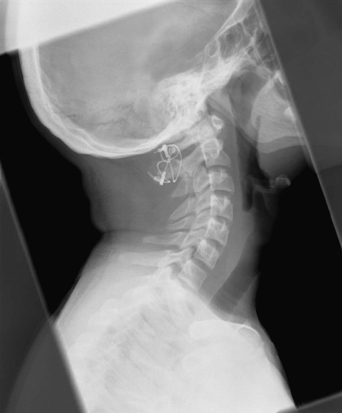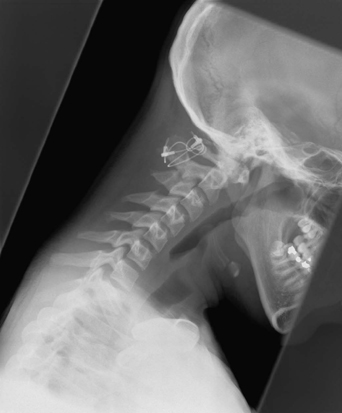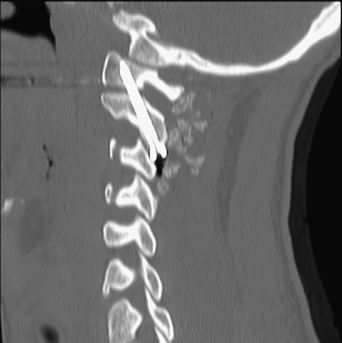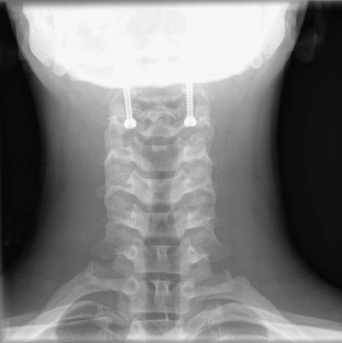4 A 17-year-old boy had a wrestling accident, resulting in neck pain without neurologic deficit. Workup demonstrated C1-C2 instability, and the patient underwent C1-C2 sublaminar fixation, but the spine did not fuse. FIGURE 4-1 Extension of cervical x-ray. On flexion-extension cervical x-ray, the atlantodental interval (ADI) widens on flexion (Figs. 4-1 and 4-2). FIGURE 4-2 Flexion cervical x-ray demonstrates widening of the ADI. FIGURE 4-3 Computed tomography reconstruction with transarticular screw displayed. Atlantoaxial instability Transarticular screws were placed (Figs. 4-3 and 4-4). The causes of atlantoaxial instability include trauma, congenital abnormality, rheumatoid arthritis, or iatrogenic injury. A series of ligaments hold together the occipitoatlantoaxial joint, such as the apical, alar, transverse, anterior, and posterior atlanto-occipital and tectoral membranes. The most important of these is the transverse ligament. An overhang of 6.9 mm or more of the C1 on 2 lateral masses on anteroposterior (AP) imaging of the cervical spine indicates an incompetent transverse ligament. The distance between the odontoid and the posterior border of the anterior arch of the atlas is called the atlantodental interval (ADI). Instability is present if this measurement is greater than 3 mm in adults and 5 mm in children. Although there is greater room for the spinal cord at this level, neurologic deficit can occur. Also, isolated neck pain can occur. At diagnosis the neck should be protected with a rigid orthosis, and surgery is needed for cases with ligamentous instability. Transarticular screws have been shown to provide a more solid fusion than posterior wiring techniques. An immediate, rigid three-column fixation with direct facet arthrodesis is achieved. This technique is viable for traumatic or inflammatory atlantoaxial instability, or for C2 pseudoarthrosis. Contraindications are an aberrant vertebral artery, inability to sufficiently align C1 and C2, or poor bone quality. This surgery is performed with biplanar fluoroscopy and neurophysiologic monitoring.
Atlantoaxial Instability
Presentation

Radiologic Findings


Diagnosis
Treatment
Discussion

Atlantoaxial Instability
Only gold members can continue reading. Log In or Register to continue

Full access? Get Clinical Tree








